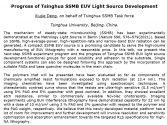A very general question if you don't mind. How does a product go from lab to commercial production like EUV or photoresist material? Say a secret lab in Tsinghua managed to develop EUV, do they sell the blueprint to SMEE or what?Those are the expected results from a size perspective.
LW is the line width, which is in the tens of nm (22-68 nm)
LER is line error roughness. that's the deviation from straightness of a feature, not the feature size itself, and note how they're limited at around 2-3 nm. So errors get bigger relative to feature size as you move down in process.
What they're doing in that paper is developing an EUV photoresist with high resolution and testing a measurement platform. many photoresists in use now for ArF processes are polymeric resists which are easy to coat (spin coating the polymer solution) but have a resolution problem.
Let's take a positive photoresist - where exposed, it becomes more soluble. These contain a photoacid generator (PAG) which is an organic molecule that turns into a water soluble acid when exposed to UV light. This acid either directly dissolves away as part of the photoresist, or reacts with the photoresist.
Here's the problem - many organic molecules are soluble in polymers due to their loose pack molecular structure and similar chemical properties. So they'll move over time. Even motion of a few nm means that the edge of the exposed feature is no longer sharp. So for EUV, they need to develop a photoresist specifically for high resolution EUV processes.
You are using an out of date browser. It may not display this or other websites correctly.
You should upgrade or use an alternative browser.
You should upgrade or use an alternative browser.
Chinese semiconductor industry
- Thread starter Hendrik_2000
- Start date
- Status
- Not open for further replies.
I'm assuming a first generation EUV would want to do at least 7nm with a single exposure. A 2-3 nm error seems like an unacceptably high error for that kind of fineness.LER is line error roughness. that's the deviation from straightness of a feature, not the feature size itself, and note how they're limited at around 2-3 nm. So errors get bigger relative to feature size as you move down in process.
Another question: This paper describes the platform used to develop photoresists, but not the photoresists themselves. Do you think that work will be published as well or kept secret?
7 nm chips aren't 7 nm. Their minimum feature size is ~40 nm.I'm assuming a first generation EUV would want to do at least 7nm with a single exposure. A 2-3 nm error seems like an unacceptably high error for that kind of fineness.
Another question: This paper describes the platform used to develop photoresists, but not the photoresists themselves. Do you think that work will be published as well or kept secret?
It's done by industry consensus (ITRS) and pooled resource labs like IMEC in Belgium:A very general question if you don't mind. How does a product go from lab to commercial production like EUV or photoresist material? Say a secret lab in Tsinghua managed to develop EUV, do they sell the blueprint to SMEE or what?
Btw apparently China got kicked out of ITRS too lmao.
Excellent analysis, there are some good news from this.Those are the expected results from a size perspective.
LW is the line width, which is in the tens of nm (22-68 nm)
LER is line error roughness. that's the deviation from straightness of a feature, not the feature size itself, and note how they're limited at around 2-3 nm. So errors get bigger relative to feature size as you move down in process.
What they're doing in that paper is developing an EUV photoresist with high resolution and testing a measurement platform. many photoresists in use now for ArF processes are polymeric resists which are easy to coat (spin coating the polymer solution) but have a resolution problem.
Let's take a positive photoresist - where exposed, it becomes more soluble. These contain a photoacid generator (PAG) which is an organic molecule that turns into a water soluble acid when exposed to UV light. This acid either directly dissolves away as part of the photoresist, or reacts with the photoresist.
Here's the problem - many organic molecules are soluble in polymers due to their loose pack molecular structure and similar chemical properties. So they'll move over time. Even motion of a few nm means that the edge of the exposed feature is no longer sharp. So for EUV, they need to develop a photoresist specifically for high resolution EUV processes.
1- Is that they don't have to wait to ASML be allowed to export a EUV machine to research and develop, masks, multilayered mirrors and photoresists.
2- Its allow them to research the possibility of using EUV SSMB as a potential EUV light source alternative, we know that necessity is the mother of invention.
Another thing, this is an study i posted earlier but in this case is made by Tsinghua and in the other study is made by Fudan university and looks like Fudan is using larger doses of EUV radiation like almost 300 mj/cm2 while Tsinghua is using 10-15 mj/cm2.

ASML scanners deliver 20mj/cm2 and that give a throughput of 80 WPH, taking into account optics and other enhancements.

If a SSMB EUV Light Source can deliver a powerful dosage of EUV radiation, that could mean that they may won't need to put as much of an effort in developing the reflective optics, even considering the losses still could deliver enough dosage. Is that a correct assessment or i am missing something?
Nice! So these tested photoresists are already very good! Is there a rule of thumb to convert between "advertised" node size and the actual minimum physical size of a feature?7 nm chips aren't 7 nm. Their minimum feature size is ~40 nm.
Also, given the heavy funding going into Chinese semiconductor fabrication and its various inputs, we might get into the rather insane situation where Chinese companies are selling photoresists to TSMC and Samsung before SMIC EUV lithography is up and running.
As far as i know how Chinese research institutions are working now is that they usually patented, they make a shell company to commercialize the product or they license the technology.A very general question if you don't mind. How does a product go from lab to commercial production like EUV or photoresist material? Say a secret lab in Tsinghua managed to develop EUV, do they sell the blueprint to SMEE or what?
U-Precision and Unisoc is a company that comes out from Tsinghua university.
Qier electromechanics was from Zhejiang university.
There is no correlation between the nameplate "N nm" size, and the actual minimum feature size.Nice! So these tested photoresists are already very good! Is there a rule of thumb to convert between "advertised" node size and the actual minimum physical size of a feature?
Also, given the heavy funding going into Chinese semiconductor fabrication and its various inputs, we might get into the rather insane situation where Chinese companies are selling photoresists to TSMC and Samsung before SMIC EUV lithography is up and running.
And yes there is the possibility of Chinese suppliers selling chemicals to other fabs before SMIC although unlikely.
ITRS is a defunct organization. It is now IEEE IRDS.It's done by industry consensus (ITRS) and pooled resource labs like IMEC in Belgium:
Btw apparently China got kicked out of ITRS too lmao.
Tsinghua is academia. They do not generally focus on direct commercialization. That is the focus of industry laboratories.A very general question if you don't mind. How does a product go from lab to commercial production like EUV or photoresist material? Say a secret lab in Tsinghua managed to develop EUV, do they sell the blueprint to SMEE or what?
- Status
- Not open for further replies.
